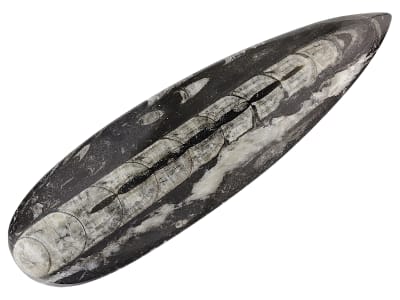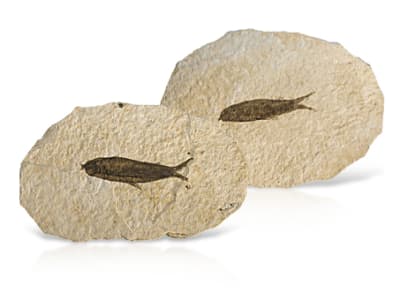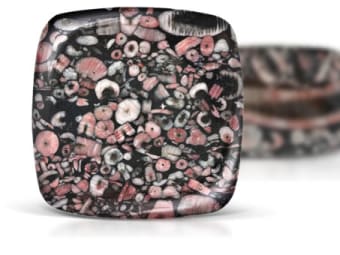Fossils are the preserved remains or traces of long dead algae, animals, and plants. The oldest known fossils are 3-billion-year-old ancient algae. The word fossil comes from the Latin word fossus which translates to “having been dug up”. For a fossil to form, an organism, or the trace of that organism, must be buried by sediment. Over long periods of time the remains will become preserved when the surrounding rocks alter the chemical and mineral composition of the remains.
General Information
Fossil Colors
-
 Black
Black -
 Brown
Brown -
 Brown
Brown -
 Gray
Gray -
 Green
Green -
 Multi-color
Multi-color -
 Red
Red -
 White
White -
 Yellow
Yellow
Countries of Origin
Papua New Guinea; Cambodia; Kazakhstan; Paraguay; Bahamas; Solomon Islands; Montserrat; Unknown; Mali; Marshall Islands; Guadeloupe; Panama; Bonaire, Sint Eustatius and Saba; Argentina; Seychelles; Belize; Zambia; Bahrain; Congo; Guinea-Bissau; Saint Barthelemy; Namibia; Comoros; Faroe Islands; Finland; Georgia; Yemen; Tanzania, United Republic Of; Eritrea; Puerto Rico; Viet Nam; Aruba; Madagascar; Libya; Sweden; Cocos (Keeling) Islands; Malawi; Andorra; Saint Helena, Ascension and Tristan da Cunha; Liechtenstein; Poland; Bulgaria; Jordan; Tunisia; Tuvalu; United Arab Emirates; Kenya; French Polynesia; Djibouti; Lebanon; Azerbaijan; Cuba; Mauritania; Saint Lucia; Guernsey; Congo (the Democratic Republic of the); Mayotte; Israel; San Marino; Australia; Tajikistan; Myanmar; Cameroon; Gibraltar; Cyprus; Northern Mariana Islands; Malaysia; Iceland; Oman; Bosnia And Herzegovina; Armenia; Gabon; Korea (the Republic of); Luxembourg; Brazil; Turks and Caicos Islands; Algeria; Cabo Verde; Jersey; Slovenia; Colombia; Ecuador; Iran (Islamic Republic of); Lao People's Democratic Republic; Vanuatu; United States Minor Outlying Islands; Honduras; Italy; Antarctica; Nauru; Haiti; Afghanistan; Burundi; Russian Federation; Singapore; French Guiana; American Samoa; Christmas Island; Netherlands; China; Martinique; Kyrgyzstan; Reunion; Saint Pierre And Miquelon; Cote D'Ivoire; Bhutan; Multiple; Romania; Falkland Islands [Malvinas]; Togo; Philippines; Uzbekistan; Pitcairn; Zimbabwe; British Indian Ocean Territory; Montenegro; Dominica; Indonesia; Benin; Angola; Virgin Islands (British); Sudan; Brunei Darussalam; Portugal; New Caledonia; Grenada; Moldova (the Republic of); Cayman Islands; Greece; Latvia; Mongolia; Morocco; Guatemala; Guyana; Iraq; Chile; Nepal; Isle of Man; Ukraine; Ghana; Holy See; Anguilla; Saint Vincent And The Grenadines; India; Canada; Maldives; Turkey; Belgium; South Africa; Bermuda; Aland Islands; Central African Republic; Jamaica; Peru; Turkmenistan; Venezuela (Bolivarian Republic of); Germany; Fiji; Tokelau; Hong Kong; Guinea; Chad; Somalia; Thailand; United Kingdom of Great Britain and Northern Ireland; Equatorial Guinea; Kiribati; Costa Rica; Saint Martin (French part); Kuwait; Nigeria; Palestine, State of; Croatia; Sao Tome And Principe; Syrian Arab Republic; Cook Islands; Sri Lanka; Uruguay; Timor-Leste; Switzerland; Samoa; Spain; Liberia; Burkina Faso; Swaziland; Palau; Estonia; Wallis and Futuna; Niue; Svalbard And Jan Mayen; Austria; Mozambique; El Salvador; Monaco; Guam; Lesotho; Tonga; Heard Island And Mcdonald Islands; Western Sahara; Hungary; Republic of Kosovo; South Sudan; Japan; Belarus; Curacao; Mauritius; Taiwan (Province of China); Bouvet Island; Albania; Bolivia (Plurinational State of); Norfolk Island; Trinidad And Tobago; Virgin Islands (U.S.); New Zealand; Sint Maarten (Dutch part); Senegal; Micronesia (Federated States of); Ethiopia; Macedonia (the former Yugoslav Republic of); Czechia; United States of America; Egypt; Sierra Leone; Malta; Saudi Arabia; South Georgia And The South Sandwich Islands; Pakistan; Gambia; Ireland; Qatar; Slovakia; France; Lithuania; Serbia; Niger; Rwanda; Saint Kitts And Nevis; French Southern Territories; Bangladesh; Barbados; Nicaragua; Norway; Botswana; Macao; Denmark; Dominican Republic; Mexico; Uganda; Suriname; Greenland; Antigua And Barbuda
Species/Variety
Crinoidal Fossil
Crinoidal fossils are pieces of animal skeleton fossils from an estimated 245 -570 million years ago. Crinoids are ancient cousins of starfish, sand dollars, sea urchins and sea cucumbers. Featuring a root-like base, a long stem-like column and then a head that resembles a flower, they look more like plants than animals, and are sometimes referred to as "sea lilies." Crinoids were so abundant that they sometimes formed vast underwater "gardens," leading to the beds of fossils we find today. Completely preserved fossils are rare, as we usually see their skeletons as a conglomeration of fossils.



